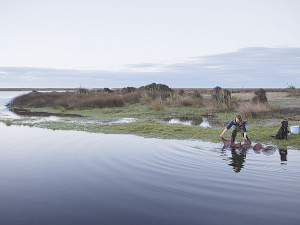Revamped Fonterra to be ‘more capital-efficient’
Fonterra chair Peter McBride says the divestment of Mainland Group is their last significant asset sale and signals the end of structural changes.
 Fonterra hopes the project will help farmers adopt biodiversity objectives into their Farm Environmental Plans and support wider catchment biodiversity goals in the process.
Fonterra hopes the project will help farmers adopt biodiversity objectives into their Farm Environmental Plans and support wider catchment biodiversity goals in the process.
A new project supported by Fonterra's Living Water Partnership with the Department of Conservation will help on-farm advisors grow their understanding of biodiversity, with a view to further building biodiversity objectives into Farm Environment Plans.
'Farming with Native Biodiversity' is a 20-month project coordinated by the NZ Landcare Trust and funded by the National Bioheritage Science Challenge, Living Water, Silver Fern Farms and the Ministry for Primary Industries (MPI).
Protecting and restoring native biodiversity on farms provides clean water, shelter, shade, carbon sequestration, drought resilience and other benefits of a healthy ecosystem.
The Living Water partnership has identified that the biggest barriers to the protection and restoration of biodiversity on farms is limited access to advice and ecological expertise, along with the cost of preparing restoration plans.
"There is widespred interest from farming communities and farm advisors to protect and restore native biodiversity on farms, though expert advice is hard to come by and costly," says Trish Kirkland-Smith, Fonterra's head of environmental partnerships.
Development of a farm biodiversity restoration and management plan can cost between $5,000 - $10,000, with additional costs for monitoring.
Across 25,000 pastoral farms in New Zealand, this is over $125 million for the planning alone.
"This new partnership project trials a more cost-effective way of providing expert advice to the sector, working with over 60 sheep and beef and dairy farms to develop biodiversity plans and implement biodiversity management, then sharing the results with 6,000 more sheep and beef farms and 9,000 dairy farms.
"There is widespread interest from farming communities and farm advisors to protect and restore native biodiversity on farms, though expert advice is hard to come by and costly."
The expected outcome of the project is that farmers adopt biodiversity objectives into their Farm Environment Plans and support wider catchment biodiversity goals in the process.
For Fonterra suppliers, these biodiversity plans will become a part of their existing Farm Environmental Plans, which Fonterra provides to farmer owners free of charge.
Effective from 1 January 2026, there will be three new grower directors on the board of the Foundation for Arable Research (FAR).
The National Wild Goat Hunting Competition has removed 33,418 wild goats over the past three years.
New Zealand needs a new healthcare model to address rising rates of obesity in rural communities, with the current system leaving many patients unable to access effective treatment or long-term support, warn GPs.
Southland farmers are being urged to put safety first, following a spike in tip offs about risky handling of wind-damaged trees
Third-generation Ashburton dairy farmers TJ and Mark Stewart are no strangers to adapting and evolving.
When American retail giant Cosco came to audit Open Country Dairy’s new butter plant at the Waharoa site and give the green light to supply their American stores, they allowed themselves a week for the exercise.
President Donald Trump’s decision to impose tariffs on imports into the US is doing good things for global trade, according…
Seen a giant cheese roll rolling along Southland’s roads?